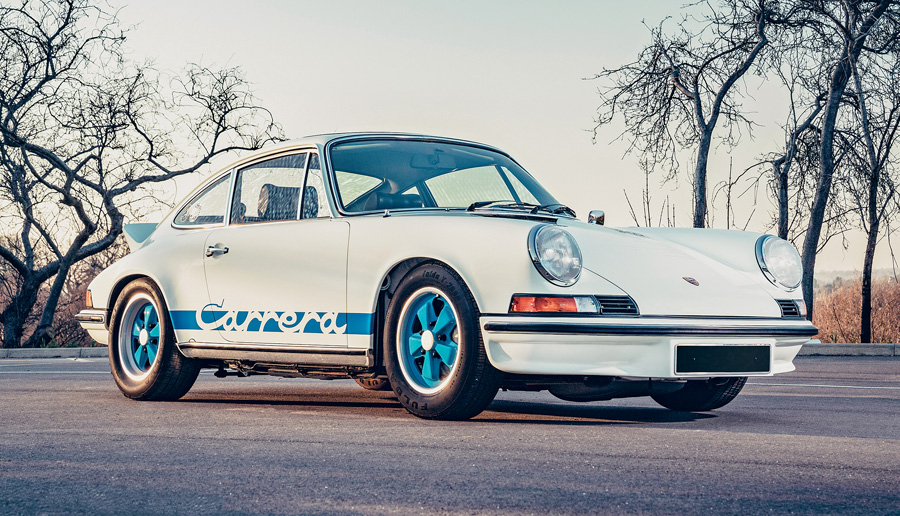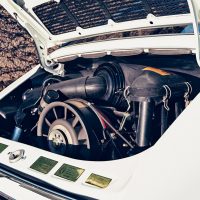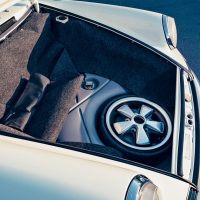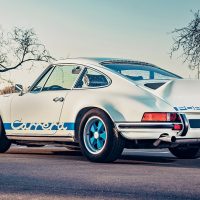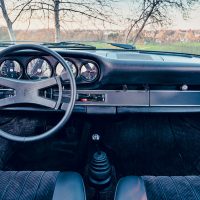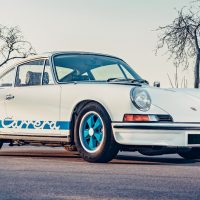SCM Analysis
Detailing
| Vehicle: | 1973 Porsche Carrera RS 2.7 Touring |
| Years Produced: | 1973 |
| Number Produced: | 200 Lightweights, 17 RSHs, 1,308 Tourings, and 55 RSRs |
| Original List Price: | $10,800 for Series 1 Tourings, $11,200 for Series 2 Tourings |
| SCM Valuation: | $658,500 |
| Tune Up Cost: | $1,000 with valve adjustment |
| Chassis Number Location: | Metal stamping in trunk, above gas tank, passenger’s side; aluminum tag on front trunk threshold; different but co-related build number under dashpad knee bar next to ashtray |
| Engine Number Location: | Vertical fan support, passenger’s side, facing right |
| Club Info: | Porsche Club of America |
| Website: | http://www.pca.org |
| Alternatives: | 1968–73 Ferrari 365 GTB/4, 1970–73 Maserati Ghibli SS 4.9, 1971–72 BMW 3.0 CSL |
| Investment Grade: | A |
This car, Lot 150, sold for $534,179, including buyer’s premium, at RM Sotheby’s Villa Erba auction in Italy on May 25, 2019.
The 1973 Carrera RS is an archetype collectible 911 — and a terrific driving car. They are the front end of many collectors’ runs of Porsche 911 RSs, which gives the model credence with even some Next Gen collectors.
We detailed the history and specifications of 1973 Carrera RSs in SCM’s August 2018 issue, pages 78–80.
After the Can-Am/Interserie era, the FIA moved to production-based race cars and thus so did Porsche. The 2,687-cc RS was the homologation base for the racing 2,806-cc RSR, for which the FIA required 500 street cars to be built. Although the Porsche Marketing Department said they couldn’t sell 500 of them, management forced the issue. The first 500 cars sold out within a week of the Carrera RS introduction in Paris during October of 1972.
Porsche made a lot of 1973 RSs
In the end, 1,525 Carrera RSs were built in three series: 1,308 Tourings, 200 Lightweights, and 17 RSHs — cars not fully converted from ultra-light homologation-weight spec. Mixed in were 55 competition RSRs — for a total of 1,580 cars.
Our August 2018 article detailed the differences between the three series. The first series ends at about serial number 527 and the second at about 1067. That becomes important because after 1067, Porsche phased out thin-gauge steel for the bodies, thin glass, fiberglass rear bumpers on LWs, aluminum front cross members and aluminum frames for the ducktails; changed the trailing arms; and added undercoating — all of which affect values.
Collectors want the original incarnations from the first and second series.
The 1973 RS is the most broadly accepted collectible 911, and the Touring variant comes to market regularly. Is the RS Touring a bellwether for collectible Porsche values? If so, what do public-sale results show us?
A second-series Touring pulls $918,500
The high-water mark for an RS Touring sold at auction came at the December 2015 RM Sotheby’s sale in New York, where Lot 218, serial number 9113601018, sold at $918,500.
That car was a late second series, in desirable Signal Yellow, with all build-sheet-matching numbers, colors, and options — including an electric sunroof. The car was fully restored.
It won the Restoration Grand Trophy at the 2008 Porsche Club of America Parade (annual meeting) in Charlotte, NC. The car had a few issues, reportedly to include one or two reproduction panels and some repro trim. It was over-restored, missing the original, slightly “messy”-looking finishes in the engine compartment, front trunk, and on the bottom.
Moving forward, there have been a number of RS Tourings at U.S. auctions since chassis 1018 sold in New York:
Serial number 911361315 in light yellow was Lot 250 at RM Sotheby’s Amelia Island in March 2017. It was fully restored but had a restamped number on a Stoddard exchange rebuilt engine, a non-matching gearbox, and some replacement trim. The car was built with stock 911 seats — later replaced by the preferred RS sport seats. The car was a no-sale. It sold privately a few months later in Colorado for $500,000 (SCM# 6831942).
Lot 159 at RM Sotheby’s Monterey in August 2017 was serial number 9113600427 in Signal Yellow. It had a sunroof and six owners from new. The car showed well but had plastic filler on it. It was a no-sale on the block. A deal was reached later that day at $649,000 (SCM# 6846596).
Serial number 9113600813, also in Signal Yellow, was Lot 131 at Gooding Monterey in August 2017. After Nicolas Cage sold it in 2002, it had six subsequent owners. This RS had matching numbers and colors, a sunroof, street 911 seats as delivered, and incorrect wheels. It was a no-sale at a reported high bid of $550,000.
Serial number 9113600574 in Bahia Red was Lot 121 at Gooding Pebble Beach in August 2018. It had matching numbers and colors, with a superb $50,000 concours repaint. It also had a sunroof (not on the build card), sports seats, and a limited-slip differential — but the wrong wheels. It sold off the block for $580,000.
Lot 192 at RM Sotheby’s October 2018 auction at Porsche Cars North America in Atlanta was serial number 9113600463 in Light Ivory. It was matching numbers and colors, optioned with sports seats, a/c, sunroof, pw, limited-slip, engine-bay lamp, and through-the-grilles driving lights. It was missing its under-bumper fog lights, and had later additions, including side scripts, a stainless rear engine skirt and a ducktail. (As delivered, the car had a “flat tail,” as on a base-model 911.) It sold for a relatively strong $698,000, including buyer’s premium. That money was fair for a first-series car with all the options (SCM# 6882332).
Serial number 9113601048 in Bahia Red was Lot 155 at RM Sotheby’s Scottsdale in January 2019. It was matching numbers, colors, and options — with sunroof, power windows, limited slip, a Webasto heater and driving lamps. It had just one owner since 1991. The car had rust on the passenger’s side bottom, and a fender and door had been replaced. It had non-Porsche seats. It sold for $467,000, including buyer’s premium (SCM# 6893287).
Lot 67 at Gooding Amelia Island in March 2019 was serial number 9113601510 in Light Ivory, with matching numbers and colors. It had one factory option — a sunroof. Added later were leather sports seats, grille-mounted driving lamps and black side scripts. The car won prizes at local and regional concours. The very capable Pat Williams rebuilt the engine. The car was bid to an indicated $380,000 and was a no-sale (SCM# 6899194).
Our RS Touring from Villa Erba
Now, let’s look at our subject car. It is a late-third-series car, in Grand Prix White with blue scripts. It had a build card-matching-numbers engine — but not gearbox — and matching colors. The seats were standard 911 issue, not RS sports seats.
It had been fully restored in the U.K., where they rectified rust in the sills, floor, front inner structure and doors. With four strikes against it — late third series, rust repairs, changed gearbox and sofa seats — this RS sold for $534,179, perhaps a strong result for this example.
So where does that leave the market?
What did we learn from these results? Most of the cars above were “driver quality” — and generally greeted with declining prices.
During the decline, both RSs and 1964–73 911s held up a little better than 930s and later Turbos. Special models with production quantities of 20 to 100 declined even less, followed by the cars with runs up to 600. That purposefully ignored newly minted “collectibles” that instantly traded over MSRP — until they didn’t, such as the 2016 911R and 2018 GT2 RS.
Our takeaway remains that a buyer’s market has been developing — and it is gaining momentum. Build cash reserves. Good buying opportunities most probably await you. ♦
Prescott Kelly is SCM’s resident Porsche guru. He’s been with us since October 2010, and we can’t imagine exploring the World of Porsche without his guidance.
